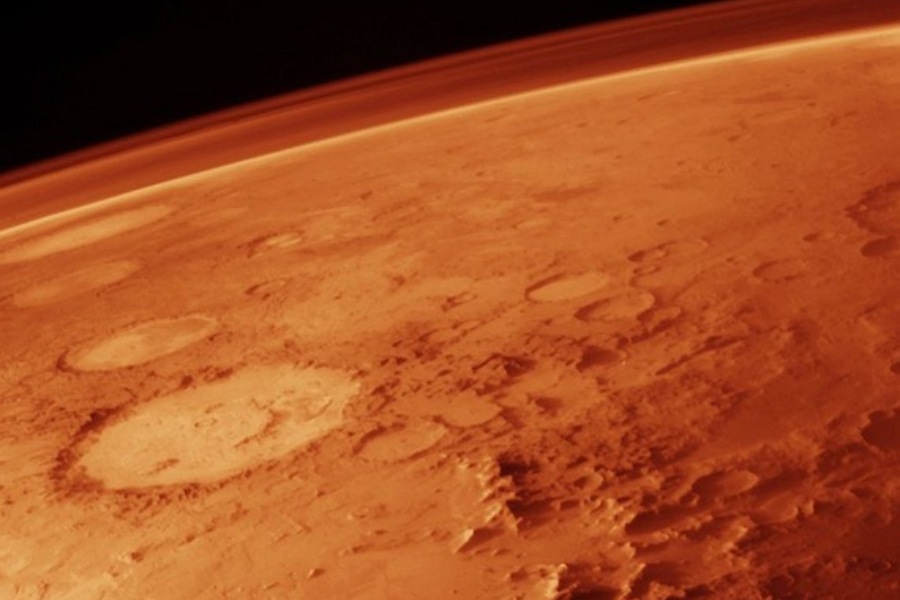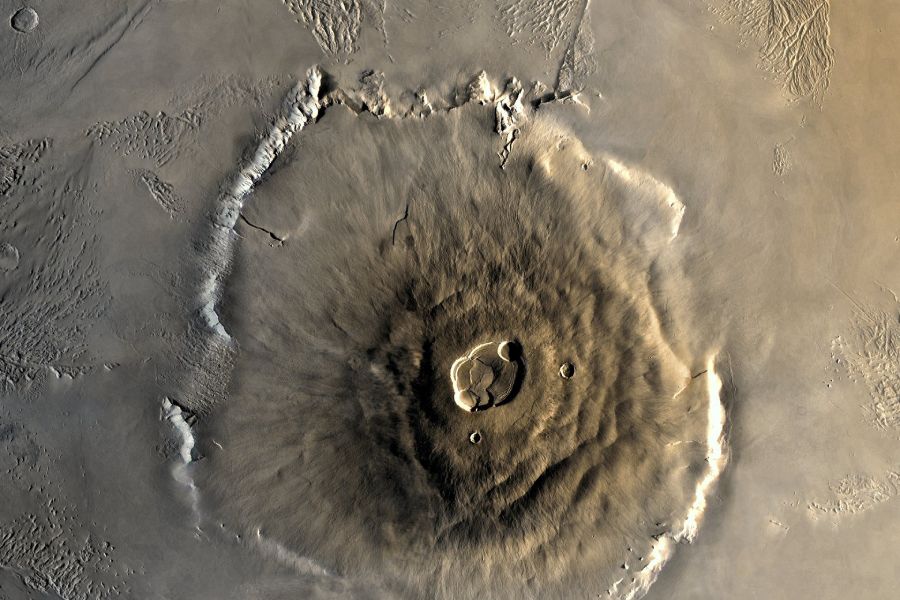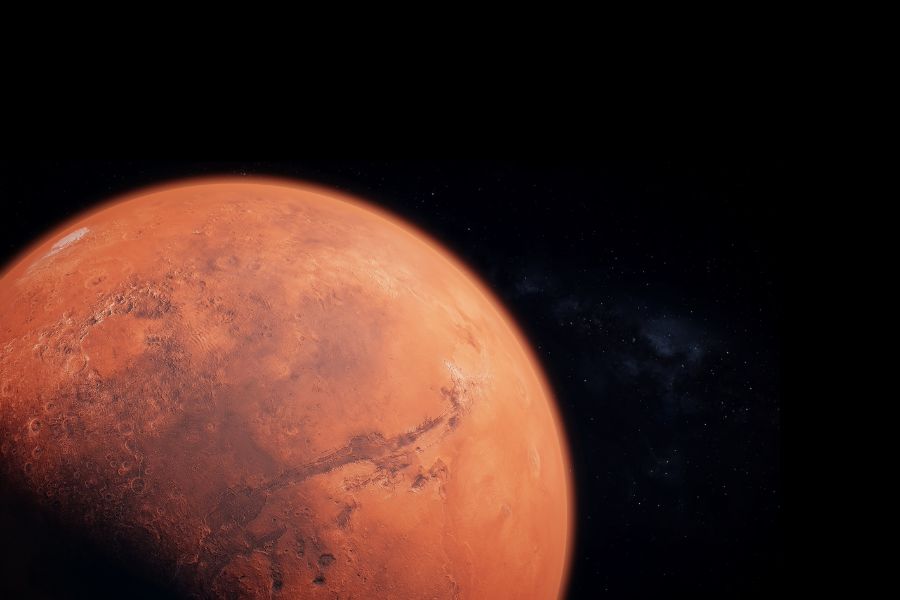When you gaze up at the night sky and spot that unmistakable red dot, you are setting your eyes on Mars. Its reddish appearance, caused by iron oxide (rust) on its surface, has been the subject of wonder and fascination for countless generations.
Ancient civilizations, including the Egyptians and the Babylonians, named it after their gods, associating its color with blood and fire. Mars‘ historical significance extends beyond mythology. It has long been a target of scientific exploration and has played a crucial role in understanding the cosmos.
Mars has been a constant source of intrigue and discovery, from early telescopic observations by astronomers like Galileo Galilei to modern-day robotic missions sent by space agencies worldwide.
Let’s uncover some of the most captivating facts about Mars, its unique characteristics, and its role in expanding our knowledge of the cosmos.
About Mars
Mars, the fourth planet from the Sun, is known for its reddish appearance. It’s about 38% the size of Earth with a thin carbon dioxide-rich atmosphere. Surface features include Olympus Mons, the largest volcano in the solar system, and Valles Marineris, a deep canyon.
Moreover, Mars has water ice at its poles, lacks a global magnetic field, has two small moons (Phobos and Deimos), and experiences extreme temperature variations and dust storms. Scientists are also investigating it for potential signs of life, and it’s a target for future human missions.

Physical characteristics of Mars
Mars has a diameter of roughly 6,794 kilometers (4,222 miles). Despite its smaller size, it possesses a considerable mass, about 0.107 times that of Earth. This mass imparts Martian gravity, which is notably weaker than Earth’s.
Size and position in the solar system
Mars orbits the Sun at an average distance of about 225 million kilometers (140 million miles), placing it in the “habitable zone” or “Goldilocks zone.” At the right distance from the Sun, this zone allows for the potential of liquid water, a crucial ingredient for life.
Surface features
Mars boasts diverse surface features, each unveiling a piece of its complex geological history:
- Volcanoes: The planet features some of the largest volcanoes in the solar system, notably Olympus Mons. This colossal shield volcano towers at approximately 13.6 miles (22 kilometers), making it nearly three times taller than Mount Everest.
- Canyons – Mars showcases Valles Marineris, an immense canyon stretching over 4,000 kilometers (2,500 miles) in length and reaching depths of up to 7 kilometers (4 miles). To put it in perspective, Valles Marineris dwarfs the Grand Canyon on Earth.
- Polar Ice Caps – Mars has polar ice caps composed of both water and dry ice (frozen carbon dioxide). These caps exhibit seasonal variations, expanding and contracting as the planet orbits the Sun. This dynamic process contributes to our understanding of the Martian climate.
Most Interesting Facts About Mars
1. Mars’ red hue
The reddish appearance of Mars is due to the presence of iron oxide (rust) on its surface. Iron-rich dust and rocks cover the planet, lending it a distinct reddish coloration that has earned it the nickname “the Red Planet”.
2. Need for spacesuits
Mars has an extremely thin atmosphere composed primarily of carbon dioxide, making it inhospitable for human life. Spacesuits are essential to provide life support systems, including oxygen, temperature regulation, and radiation protection.
3. Position in the solar system
Mars is the fourth planet from the Sun, located between Earth and Jupiter. This position has made it a prime target for exploration and study due to its proximity to Earth.
4. Martian year
A year on Mars, known as a “Martian year,” is longer than an Earth year, lasting approximately 687 Earth days. This extended year results in longer seasons on the planet.
5. Olympus Mons
Olympus Mons is the largest volcano in the solar system, rising approximately 13.6 miles (22 kilometers) above the Martian surface. It is a shield volcano formed billions of years ago through volcanic activity.
6. Four Martian seasons
Mars experiences four seasons similar to Earth: spring, summer, autumn, and winter. However, the Martian seasons are nearly twice as long due to its longer orbital period.
7. Extreme cold
Mars is known for its frigid climate, with average surface temperatures hovering around -80 °F (-62 °C). During the harsh winters in the polar regions, temperatures can plummet to an astounding -195 °F (-125 °C).
8. Size comparison
Mars is about half the size of Earth, with a diameter of approximately 6,794 kilometers (4,222 miles). This smaller size contributes to its lower gravity, approximately 38% of Earth’s.
9. Robotic exploration
Mars has been the target of numerous robotic missions, including rovers like Spirit, Opportunity, Curiosity, and Perseverance. These rovers have conducted experiments, analyzed Martian soil and rock samples, and sent valuable data back to Earth.
10. Roman god namesake
Mars is named after the Roman god of war, reflecting its reddish appearance, often associated with blood and conflict. In Roman mythology, Mars was also regarded as a guardian of agriculture.
11. Chilling temperatures
Mars’s thin atmosphere and greater distance from the Sun contribute to its extreme cold. Temperatures can vary widely but rarely rise above freezing, even in the warmest locations.
12. Martian soil
The surface material on Mars is called regolith, a layer of loose, fragmented material that covers solid bedrock. Understanding the Martian regolith is crucial for potential resource utilization and colonization.
13. Two Martian moons
Mars has two small moons, Phobos and Deimos. These irregularly shaped moons are believed to be captured asteroids. Phobos orbits much closer to Mars, while Deimos orbits farther out.
14. Longer Martian days
A day on Mars, known as a “Sol“, is only slightly longer than an Earth day, lasting approximately 24 hours and 37 minutes. This similarity in day length facilitates mission planning and scheduling for future explorations.
15. Low gravity impact
Mars’ lower gravity, about 38% of Earth’s, means that visitors would experience significantly reduced weight. This lower gravitational pull allows for higher jumps and easier mobility.
16. Crater-laden landscape
Mars bears the scars of countless impact craters on its surface, providing insights into its geological history and the frequency of cosmic collisions over billions of years. These craters also serve as potential sites for studying Martian subsurface geology.
17. Thin Martian atmosphere
Mars has a thin atmosphere primarily composed of carbon dioxide (about 95%), with trace amounts of other gases like nitrogen and argon. This thin atmosphere provides little protection from radiation and little support for human respiration.
18. Surface water presence
While liquid water cannot exist on Mars’s surface due to its low atmospheric pressure, water ice exists at the polar caps, and evidence suggests the presence of underground water ice. Seasonal flows of briny water have also been observed on steep slopes.
19. Magnetic field absence
Unlike Earth, Mars lacks a global magnetic field. This absence leaves its surface exposed to harmful solar and cosmic radiation, making radiation protection a crucial consideration for future missions.
20. Astrobiology quest
Mars is a focal point in the search for extraterrestrial life. Scientists and space agencies actively explore the planet for signs of past or present microbial life, with missions like NASA’s Perseverance rover equipped with instruments designed to investigate potential biosignatures and habitability.
Mars’s Distinctive Red Hue
Mars, often referred to as the “Red Planet,” owes its striking reddish appearance to the prevalence of iron oxide, commonly known as rust, on its surface. This distinctive coloration has fascinated astronomers and planetary scientists for centuries.
The role of iron oxide (Rust)
The primary contributor to Mars’s reddish color is iron oxide, a compound formed by iron oxidation or rusting when exposed to oxygen and water.
Iron-rich dust and rocks are abundant on the Martian surface, giving the entire planet its characteristic reddish hue. The oxidation process on Mars is thought to have occurred over billions of years, gradually covering the surface with a layer of rust.
Geological and chemical factors
Mars’s reddish appearance is not only due to the presence of iron oxide but also the planet’s unique geological and chemical characteristics. The iron-rich material is spread across the Martian surface, creating a layer that ranges in thickness. This iron-laden regolith, or surface material, interacts with sunlight to enhance its reddish coloration.
Additionally, the geological history of Mars has played a role in the distribution of iron-rich materials. Erosion, volcanic activity, and the formation of impact craters have exposed these materials, contributing to the overall reddish appearance.
Mars’s atmosphere and habitability
Mars boasts a thin atmosphere composed primarily of carbon dioxide (about 95%), with trace amounts of other gases like nitrogen and argon. Understanding its atmosphere is crucial for assessing the potential for human habitation and terraforming.
Composition of Mars’s thin atmosphere
Mars’s atmosphere, while thin compared to Earth’s, plays a crucial role in the planet’s climate and surface conditions. The atmosphere’s composition is primarily carbon dioxide, making it inhospitable for humans. Its thinness also provides little protection from harmful solar and cosmic radiation.
The need for spacesuits and life support systems
Due to Mars’s thin atmosphere and lack of oxygen, human exploration of the planet requires advanced life support systems and spacesuits. These systems must provide a stable oxygen supply, remove carbon dioxide exhaled by astronauts, regulate temperature, and protect against radiation. The challenge of creating self-sustaining habitats on Mars is a key focus of future exploration efforts.
The potential for terraforming and colonization
The possibility of terraforming Mars, transforming its environment to make it more Earth-like and habitable for humans, is a topic of ongoing scientific research and speculation.
Proposed methods include increasing the planet’s atmospheric pressure and temperature, introducing greenhouse gases, and creating sustainable ecosystems. While these ideas are currently in the realm of science fiction, they represent ambitious goals for potential long-term human colonization.
Mars’ unique orbital dynamics
Mars’s orbital characteristics, including its longer year and distinct relationship with Earth, offer valuable insights into its climate and seasons.
Understanding the Martian year and its longer seasons
A year on Mars, known as a “Martian year,” is significantly longer than an Earth year, lasting approximately 687 Earth days.
This extended year results in longer seasons on the planet, each lasting roughly twice as long as Earth’s seasons. The varying distance between Mars and the Sun during its elliptical orbit contributes to the planet’s seasonal changes.
The relationship between Mars and Earth in the solar system
Mars’s position in the solar system, located between Earth and Jupiter, has made it a prime target for exploration and study due to its relative proximity to our planet.
The alignment of Mars and Earth in their orbits is crucial in mission planning and interplanetary travel. Mission launch windows occur every 26 months, allowing for efficient travel between the two planets.
Martian Days and Low Gravity
Mars has its unique day-night cycle and lower gravity compared to Earth, which has significant implications for future human missions to the planet.
Understanding the Martian Day or “Sol”
A day on Mars, known as a “Sol”, is only slightly longer than an Earth day, lasting approximately 24 hours and 37 minutes. This similarity in day length facilitates mission planning and scheduling for future explorations. However, the Martian environment presents unique challenges due to its thin atmosphere and extreme temperatures, which affect daily routines and equipment.
Implications of lower gravity on human activity
Mars’s lower gravity, approximately 38% of Earth’s, means that visitors would experience significantly reduced weight.
While this reduced gravitational pull allows for higher jumps and easier mobility, it also has health implications for long-term human habitation. Prolonged exposure to lower gravity can lead to muscle and bone loss, cardiovascular changes, and other physiological effects, making it a key consideration for future colonists.
The Martian Landscape: Impact Craters and Regolith
Mars’s surface is marked by numerous impact craters and covered in regolith, which provide valuable insights into its geological history and potential resources.
The role of impact craters in Martian geology
Impact craters on Mars, formed by the collision of celestial objects such as asteroids or comets, offer a window into the planet’s geological past. These craters vary in size and age, with some being relatively recent and others dating back billions of years.
Studying Martian craters helps scientists understand the frequency of cosmic collisions and their impact on the planet’s surface.
Significance of regolith for potential colonization
The Martian surface is covered with regolith, a loose, fragmented material covering the solid bedrock. Understanding Martian regolith is crucial for potential colonization efforts, as it may contain resources like water, ice, and minerals that could be extracted and used to support human settlements.
Regolith could be utilized for building materials, shielding against radiation, and growing plants in controlled environments.
Mars’s Thin Atmosphere and Radiation Exposure
Mars’s thin atmosphere presents challenges for human missions, particularly in terms of radiation exposure.

The composition of the Martian atmosphere
Mars has a thin atmosphere primarily composed of carbon dioxide (about 95%), with trace amounts of other gases like nitrogen and argon.
This thin atmosphere provides little protection from harmful solar and cosmic radiation, which poses health risks to humans and limits the planet’s habitability. Future missions will need to address these radiation concerns through advanced shielding and habitat design.
The challenge of radiation protection for future missions
Protection against radiation is a critical consideration for future missions to Mars. The thin Martian atmosphere offers minimal shielding, leaving astronauts vulnerable to cosmic rays and solar radiation.
Space agencies are actively researching and developing technologies to mitigate these risks, including designing spacecraft and habitats with radiation-shielding materials and studying the effects of long-duration space travel on human health.
Water on Mars
Mars holds vital clues about the presence of water, both in the form of ice and potentially underground.
The presence of water ice at the polar caps
Mars has polar ice caps composed of both water ice and dry ice (frozen carbon dioxide). These polar caps exhibit seasonal variations, expanding and contracting as the planet orbits the Sun.
The presence of water ice is a valuable resource for future human missions. It can potentially be melted and purified for drinking water and used for various other purposes, including agriculture and fuel production.

Evidence for underground water and seasonal flows
Evidence suggests that Mars may contain underground water ice, potentially in liquid form beneath the surface. Seasonal flows of briny water have been observed on steep slopes during warmer months, sparking intrigue about the possibility of subsurface aquifers.
Discovering and accessing these subsurface water sources could be crucial for supporting future human colonies and life on the Red Planet.
Frequently Asked Questions
How hot is Mars?
Mars experiences various temperatures due to its thin atmosphere and greater distance from the Sun compared to Earth. On average, surface temperatures on Mars hover around -80 °F (-62 °C).
However, temperatures can vary significantly depending on the location and time of day. In the polar regions during winter, temperatures can plummet to an extreme -195 °F (-125 °C), while daytime temperatures in equatorial regions may briefly reach around 70 °F (20 °C).
The thin atmosphere contributes to rapid temperature fluctuations, with frigid nights and relatively milder daytime temperatures.
How far is Mars from Earth?
The distance between Earth and Mars varies continuously because both planets orbit the Sun. On average, Mars is approximately 225 million kilometers (140 million miles) away from Earth.
However, the actual distance can range from about 54.6 million kilometers (33.9 million miles) at their closest approach (opposition) to approximately 401 million kilometers (249 million miles) when they are on opposite sides of the Sun (conjunction).
The two planets align favorably for interplanetary missions every 26 months, allowing for efficient travel between them.
Can humans breathe on Mars?
No, humans cannot breathe on Mars without artificial life support systems. Mars’s thin atmosphere consists mainly of carbon dioxide, with minimal oxygen content. To survive, humans would require spacesuits equipped with oxygen supplies and advanced life support systems to maintain breathable conditions.
Conclusion
Mars, the Red Planet, has captivated humanity for centuries with its distinctive color and enigmatic nature. From ancient mythological associations to modern-day scientific exploration, Mars symbolizes our unrelenting curiosity and quest for knowledge.
Going through the fascinating facts about Mars, we’ve uncovered its unique features, differences from Earth, and ongoing exploration efforts. From colossal volcanoes to frigid winters and the search for signs of life, Mars continues to inspire us to explore the cosmos.
As we gaze at the night sky and spot that unmistakable red dot, let Mars remind us of our enduring spirit of exploration, propelling us toward the next frontiers of human discovery.

